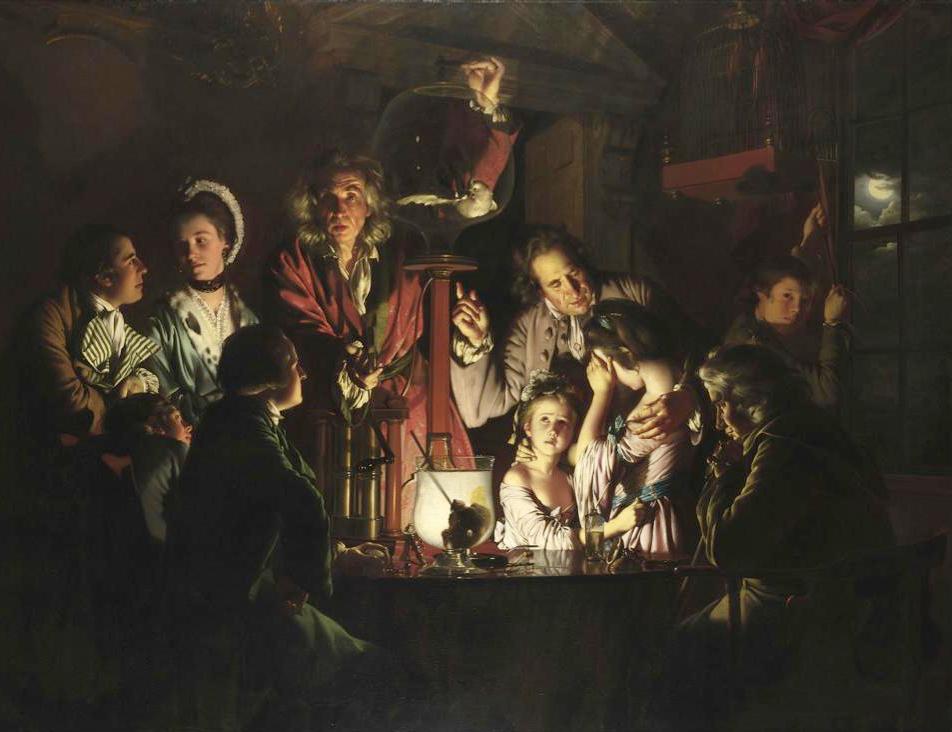
A “science party,” as depicted by Joseph Wright of Derby in 1768. Here, an itinerant scientist demonstrates a vacuum pump in the parlor of a well-to-do household.
About two years ago, I was conducting research at the Bakken Museum in Minneapolis when Mia curator Nicole LaBouff approached me with a question about solar microscopes. She was planning an exhibition called “Science and Sociability in 1700s England,” now open in the Queen Anne and Georgian period rooms at Mia. The Georgian Drawing Room is arranged as though for a “scientific party,” featuring telescopes and microscopes amid the paintings and fireplace. In 1700s England, this is how natural history was generally discussed—sociably, by men and women in genteel homes. And one of the instruments that made it sociable was the solar microscope.
In 2004, I had the opportunity to work with solar microscopes at the Deutsches Museum Munich, in Germany. The description of these instruments in academic literature at the time was fairly basic: they were developed in the mid-1700s, became particularly popular during the Enlightenment (the two instruments I used dated to about 1780 and 1791), and worked like projection microscopes, using a mirror and lens system to reflect sunlight and illuminate a microscopic specimen. They projected an image of the specimen onto a wall, like a slide show.
Looking into literature from the 1700s, however, a puzzling discrepancy emerged. Several historians of science sketched the instrument as a toy, an amateur device that offered barely satisfactory image quality. Natural philosophers of the time gave a completely different impression, describing the images as huge, bright, and “beyond the imagination of those who had not seen it”—a phrase that was repeated throughout the literature.

The Nordertor, or old city gate, in Flensburg, where projections were made with the solar microscope.
I needed to see for myself, and proposed a re-enactment of the instruments to the Deutsches Museum. They agreed, and even cleaned up the specimens that had come with the instruments, offering the option of projecting authentic, late-1700s objects. But first we needed a suitable room. The darker the room, according to my sources, the more impressive the images. I spent several days squeezing the light out of a lab, with a wooden shutter in one of the windows. In the shutter, a hole was made in which the solar microscope could be inserted.
The solar microscope was placed in the hole, with the mirror outside the window. After some adjustment to the mirror, light entered the dark room through the instrument and created a bright circular spot on the projection screen. When I placed the first specimen into the instrument, I got an image on the screen that was bright, clear, and huge.
It was just as the natural philosophers had claimed, beyond the imagination of anyone who had not seen it. Moreover, using the solar microscope was substantially different from using other microscopes. If a traditional microscope mediates between two worlds, that of the microscopic and the macroscopic, then a solar microscope brings the worlds together, a room in which the observer can stand with the inhabitants of the microcosm. The world as we know it can no longer be perceived in the usual manner. Indeed, the observational situation is totally different, and it is impressive to share a room with a flea the size of a car.
However, the solar microscope is critically dependent on the weather (basically, “no sun, no show”), and this was the experience of visitors to my lab at the Deutsches Museum—just like scientific party-goers in the 1700s. This is a problem, of course, for a museum hoping to demonstrate one of these instruments, and Mia decided to go in a different direction. Instead of showing the instrument in use, they chose to show photographs of the images as they were projected under ideal circumstances.
To do this in a historical context, we prepared specimens according to an 18th century description by Benjamin Martin, a London-based instrument maker who built a number of solar microscopes. The images were projected by a reconstruction of an instrument made by Martin, now kept at the Universiteitsmuseum Utrecht.
By then, I was working in Flensburg, Germany, and needed a new room to project the specimens. We found such a place in the Nordertor, the old city gate of Flensburg, now part of the Phänomenta science center. They use the upper floor of the Nordertor for the so-called Café Lichtlos—a café without any bits of light. It was perfect for our purposes. We sealed the windows with wooden shutters andmade a hole in one of them. Then we waited for sunny days. When we finally had one, we needed just a few hours to produce the images you can now see at Mia.
You can see Peter Heering’s photographs of solar-microscope projections—as well as a microscope and books by Benjamin Martin—in the “Science and Sociability” installation at Mia (as shown at top), on view in the Georgian Drawing Room through April 2018.



